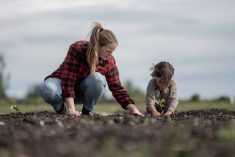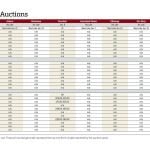rant Vermeulen believes that farming with $150 in owned machinery per acre is agronomically possible. The harder question, he says, is whether it’s good business. In an industry that is increasingly built on cost control, the answer should seem obvious. But for Vermeulen and others across the country, it isn’t.
Vermeulen farms with his brother Mark and their father Ron at Vermeulen Farms near Ceylon, Sask. where they run 9,000 acres and have a 300 head cow-calf operation. For them, crucial factors in any machinery equation have to include the impact of machinery inventory on timeliness of field operations, its impact on their ability to grow, and its impact on their overall financial management.
Read Also

Building a farm legacy that outlasts you
A farm’s legacy isn’t just about the land; it’s also about the values and the impact that continue long after the current owner has stepped away.
Grant and Mark think the accountants and advisers know the numbers, but not necessarily the realities of farming.
“When you get big enough you can take on another quarter section and it’s just another day,” Grant says. That means having an equipment inventory that gives you flexibility. “For a smaller guy, that might mean another week, or
he has to expand his equipment line. It’s about economies of scale.”
Inventory also lets them put together an operation that actually works, the brothers say. Labour availability is just one example. Advisers will argue one large piece is always better than two smaller ones, but the Vermeulens aren’t so hard and fast with any of their machinery rules. At one time they
Reading the numbers
If there is one word Dean Klippenstine wants farmers to consider when they purchase equipment for their operations, it’s “benchmarks.”
His ninth-floor office looks out over downtown Regina and he wears a suit to work, but Klippenstine is no stranger to farming. For 20 years he was financially and physically involved in a mixed farm with his family, and now as a chartered accountant he is an agriculture specialist with Meyers Norris Penny.
Machinery inventory is emerging as a crucial issue for his clients, Klippenstine says, and for agriculture overall.
“I am passionate about this,” Klippenstine says. “Farms are, as a rule, overmachined.”
It’s already showing up on the bottom lines of farmers in his region, he says. “Machinery can be a significant factor in reducing farm profitability if it’s done wrong.”
Repair or replace? Upgrade or maintain? What is most feasible and when? Klippenstine says an annual look at benchmarks takes the guesswork and emotion out of decision-making. “They are the litmus tests I use to tell producers if what they’re planning is a good idea or not.”
Benchmarks are set by taking the top 10 producers from an area where all major aspects of the farm would be comparable, such as crop rotations, soil type, insect and weather issues. “If two farms with the same production capability in the same area have $50 and $85 per acre annual machinery costs, it means the second guy made some purchases that were obviously not necessary,” Klippenstine says.
kept one seeder going round the clock but found it difficult to keep up and to find the 24-hour manpower to do it. Now they have two seeders running 12-hour days, and are more efficient because of it.
Plus, the timing of major purchases also has to work in with the entire farm, they add. The Vermeulens have just bought a new sprayer. It’s bigger and can cover more acres, especially with the number of applications required for a variety of special crops, says Mark. “And we wanted to trade while the old one had some value left in it,” he adds. “Good crops and commodity prices meant we could afford it now. We bought a combine two years ago in much the same situation.”
So cash on hand is another factor for the Vermeulens, though both are comfortable with debt that pencils out. “I don’t have a problem with taking on debt for a combine or a sprayer or something that’s going to make you money,” Grant says. “I just can’t see taking a loan for a Skidoo or a camper. It doesn’t make sense to me.”
Whether to trade or fix is an issue on any farm. “You can spend $250,000 to upgrade or you might fix it for $50,000 and it’s going to work the same,” says Grant.
Some things, too, just have to be replaced, particularly if they blow up at a critical time. “Then we’ll definitely look at a loan,” Mark says. “There’s too much to do to have down time.”
That said, the Vermeulens also know that the accountants are on to something real. Managing the cost of their equipment inventory is a critical job. It’s already make-or-break, and if anything, making wise decisions is getting even tougher.
Sums up Grant: “Farming with money is different than farming to make money.”
Farmers in the second category may be making one of three mistakes. They may be buying on impulse. Or they may be buying to receive a tax benefit. (“I’d rather see guys make money and pay tax than spend money on capital unnecessarily,” Klippenstine says.)
Third, they may be buying simply because they can afford it, Klippenstine says. “Excess capital left in the business makes machinery purchases easy but they are not necessarily driven by Klippenstine: No guesswork.
the economics of the purchase.”
This last hits a nerve with Klippenstine, who believes years
of buying “too much new stuff and too many pieces” has led to what might become a crisis.
“Complacency with excess machinery causes farms at the high end to get into trouble. This generation instills excess capital habits in the next generation who don’t have the same wealth as their parents did or do. They get an ‘I need to have it mentality,’” he says. It happened in the mid-70s and Klippenstine says he’s seeing it happen again due to strong yields and relatively good commodity prices over the last couple years.
While he concedes there is some legitimate catching up to do to make up for the lean years, Klippenstine warns producers to carefully weigh purchases in terms of need. “In tight times you have to be perfect,” he says. “You don’t want a few good years to get you off a solid business course.”
Making tough decisions
Accountants will include fuel, repairs and maintenance, depreciation, and wages to assess annual per-acre costs. Then they’ll compare these totals against custom or rental rates, determine whether purchasing, renting or hiring custom operators is appropriate. When buying equipment, it’s a matter of prioritizing, Klippenstine says. Which piece will increase efficiency, timeliness, yields — replacing your pull-type sprayer or buying a land roller. The answers become pretty obvious when the economic impact is examined.
There are also solid long-term benchmarks to follow. David Sullivan, another MNP ag adviser and member of the Canadian Association of Farm Advisors, says $150 of owned machinery per acre is the benchmark for most Saskatchewan farms.
Many producers might say it’s impossible, but Sullivan says they aren’t seeing the collective effect of their equipment purchases on the bottom line.
It’s like a yo-yo on an ever-shortening string, Sullivan says. A farmer just starting out might be at $200 per acre and depreciate the equipment down to or below the $150 target. Then he buys a large piece of equipment and that number necessarily goes up to $300. Instead of waiting long enough for depreciation to bring the figures down, he only comes down to $200 before buying another piece and might then go up to $400, so that over the years his owned machinery costs bounce higher and higher.
Klippenstine says it’s all about planning and realizing that “just because you can afford it, doesn’t mean it makes sense. If someone will take out a loan to buy equipment, it’s probably a legitimate purchase because people are more careful about this kind of thing.”
The best way to avoid the temptation to buy unnecessary equipment is to “take capital out of the business and put it somewhere else.” If the money is invested elsewhere it “creates a mental hurdle” to jump before deciding to purchase something.
While he concedes there is some legitimate catching up to do to make up for the lean years, Klippenstine warns producers to carefully weigh purchases in terms of need. “In tight times you have to be perfect,” he says. “You don’t want a few good years to get you off a solid business course.”
Making tough decisions
Accountants will include fuel, repairs and maintenance, depreciation, and wages to assess annual per-acre costs. Then they’ll compare these totals against custom or rental rates, determine whether purchasing, renting or hiring custom operators is appropriate. When buying equipment, it’s a matter of prioritizing, Klippenstine says. Which piece will increase efficiency, timeliness, yields — replacing your pull-type sprayer or buying a land roller. The answers become pretty obvious when the economic impact is examined.
There are also solid long-term benchmarks to follow. David Sullivan, another MNP ag adviser and member of the Canadian Association of Farm Advisors, says $150 of owned machinery per acre is the benchmark for most Saskatchewan farms.
Many producers might say it’s impossible, but Sullivan says they aren’t seeing the collective effect of their equipment purchases on the bottom line.
It’s like a yo-yo on an ever-shortening string, Sullivan says. A farmer just starting out might be at $200 per acre and depreciate the equipment down to or below the $150 target. Then he buys a large piece of equipment and that number necessarily goes up to $300. Instead of waiting long enough for depreciation to bring the figures down, he only comes down to $200 before buying another piece and might then go up to $400, so that over the years his owned machinery costs bounce higher and higher.
Klippenstine says it’s all about planning and realizing that “just because you can afford it, doesn’t mean it makes sense. If someone will take out a loan to buy equipment, it’s probably a legitimate purchase because people are more careful about this kind of thing.”
The best way to avoid the temptation to buy unnecessary equipment is to “take capital out of the business and put it somewhere else.” If the money is invested elsewhere it “creates a mental hurdle” to jump before deciding to purchase something.
Meanwhile, at the dealership
While farmers might discuss their equipment needs with advisers and accountants once or twice a year, the machinery dealer is on the front line. Frank Tuchscherer manages Nelson Motors and Equipment, a John Deere dealership in Radville, Sask. He knows his customers, their operations, the people involved and where they’re at in their farming lives.
Key to helping them is personal knowledge of their buying decision questions. “Maybe the combine they’re looking at is too big for what they need. Maybe they could buy a swather with a smaller combine and make the whole operation more efficient,” Tuchscherer says.
Tuchscherer knows his customers and he knows their foibles. He believes 75 per cent of farmers have a plan, but only about 25 per cent have it written down. Half of these come in to discuss where they are and where they want to be in the future. “It greatly affects their buying decisions,” Tuchscherer says, “because they can do more research and get in on savings when they are available. They have a lot more choice.” He also believes bankers are more likely to look favour-ably on a loan application where the need is justified with a long-term plan.
Some producers do buy simply because they have the money, Tuchscherer says. “Twelve-dollar durum gave people a false sense of wealth. In reality only a small percentage of the crop was sold for that price,” he says, “but you hear about it in the media and from neighbours and think things are going to be great.”
But most producers make their decisions based on a variety of factors. Increased acreage often leads to increased equipment needs. Labour shortages have had an impact on buying decisions. Producers trade two machines for one larger unit because it reduces human resource needs.
Meanwhile, at the dealership
While farmers might discuss their equipment needs with advisers and accountants once or twice a year, the machinery dealer is on the front line. Frank Tuchscherer manages Nelson Motors and Equipment, a John Deere dealership in Radville, Sask. He knows his customers, their operations, the people involved and where they’re at in their farming lives.
Key to helping them is personal knowledge of their buying decision questions. “Maybe the combine they’re looking at is too big for what they need. Maybe they could buy a swather with a smaller combine and make the whole operation more efficient,” Tuchscherer says.
Tuchscherer knows his customers and he knows their foibles. He believes 75 per cent of farmers have a plan, but only about 25 per cent have it written down. Half of these come in to discuss where they are and where they want to be in the future. “It greatly affects their buying decisions,” Tuchscherer says, “because they can do more research and get in on savings when they are available. They have a lot more choice.” He also believes bankers are more likely to look favour-ably on a loan application where the need is justified with a long-term plan.
Some producers do buy simply because they have the money, Tuchscherer says. “Twelve-dollar durum gave people a false sense of wealth. In reality only a small percentage of the crop was sold for that price,” he says, “but you hear about it in the media and from neighbours and think things are going to be great.”
But most producers make their decisions based on a variety of factors. Increased acreage often leads to increased equipment needs. Labour shortages have had an impact on buying decisions. Producers trade two machines for one larger unit because it reduces human resource needs.
Advances in technology, particularly in seeding and harvest, can provide real benefits to farmers, but Tuchscherer cautions “only if it increases productivity or efficiency so yields and grades are increased.”
He points to a huge increase in sales of GPS products of all kinds that make every job a lot easier and more precise. “Forward-thinking farmers are looking at prescription seeding. It costs money to write the prescription for your land, but the savings are in agronomic applications.”
“It’s up to producers to assess the cost/benefit of this kind of technology.”
Some farmers who want the new technology are finding innovative ways to afford it. Producers have formed informal co-ops. Or they buy equipment with an understanding their neighbours will rent it or pay them to do the particular operation.
Farmers can also lease equipment. “It’s just another form of financing,” Tuchscherer says. “The question is when do you want to pay the big money?”
Whether producers have a formal plan in place or not, Tuchscherer says at the very least they should be looking six months ahead. “Not that the price will change much but there are more programs on early, more choices and you can get what you want.”
It all leaves the Vermeulens with tough decisions, knowing that somehow they have to build bridges between what their accountant is telling them, what their dealers is showing them, and what they know about what it takes to run their farm.
Then it gets trickier. The Vermeulens see the future in different ways. Mark and Ashlee have three children. Grant and Susan have no children and plan to retire out of farming in the next ten years or so.
The challenge, they all agree, will be to plan the farm and future equipment purchases around very diverse needs. CG
Advances in technology, particularly in seeding and harvest, can provide real benefits to farmers, but Tuchscherer cautions “only if it increases productivity or efficiency so yields and grades are increased.”
He points to a huge increase in sales of GPS products of all kinds that make every job a lot easier and more precise. “Forward-thinking farmers are looking at prescription seeding. It costs money to write the prescription for your land, but the savings are in agronomic applications.”
“It’s up to producers to assess the cost/benefit of this kind of technology.”
Some farmers who want the new technology are finding innovative ways to afford it. Producers have formed informal co-ops. Or they buy equipment with an understanding their neighbours will rent it or pay them to do the particular operation.
Farmers can also lease equipment. “It’s just another form of financing,” Tuchscherer says. “The question is when do you want to pay the big money?”
Whether producers have a formal plan in place or not, Tuchscherer says at the very least they should be looking six months ahead. “Not that the price will change much but there are more programs on early, more choices and you can get what you want.”
It all leaves the Vermeulens with tough decisions, knowing that somehow they have to build bridges between what their accountant is telling them, what their dealers is showing them, and what they know about what it takes to run their farm.
Then it gets trickier. The Vermeulens see the future in different ways. Mark and Ashlee have three children. Grant and Susan have no children and plan to retire out of farming in the next ten years or so.
The challenge, they all agree, will be to plan the farm and future equipment purchases around very diverse needs. CG














